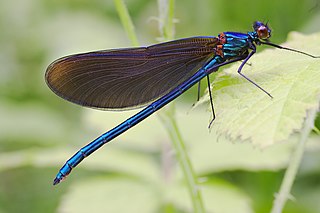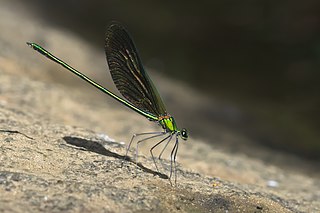
Odonata is an order of predatory flying insects that includes the dragonflies and damselflies. The two groups are distinguished with dragonflies usually being bulkier with large compound eyes together and wings spread up or out at rest, while damselflies are usually more slender with eyes placed apart and wings folded together along body at rest. Adult odonates can land and perch, but rarely walk.

A dragonfly is a flying insect belonging to the infraorder Anisoptera below the order Odonata. About 3,000 extant species of dragonflies are known. Most are tropical, with fewer species in temperate regions. Loss of wetland habitat threatens dragonfly populations around the world. Adult dragonflies are characterised by a pair of large, multifaceted, compound eyes, two pairs of strong, transparent wings, sometimes with coloured patches, and an elongated body. Many dragonflies have brilliant iridescent or metallic colours produced by structural coloration, making them conspicuous in flight. An adult dragonfly's compound eyes have nearly 24,000 ommatidia each.

Damselflies are flying insects of the suborder Zygoptera in the order Odonata. They are similar to dragonflies but are usually smaller and have slimmer bodies. Most species fold the wings along the body when at rest, unlike dragonflies which hold the wings flat and away from the body. Damselflies have existed since the Late Jurassic, and are found on every continent except Antarctica.

The Calopterygidae are a family of damselflies, in the suborder Zygoptera. They are commonly known as the broad-winged damselflies, demoiselles, or jewelwings. These rather large damselflies have wingspans of 50–80 mm, are often metallic-coloured, and can be differentiated from other damselflies by the broader connection between the wings and the body, as opposed to the abrupt narrowing seen in other damselfly families. The family contains some 150 species.

The Lestidae are a rather small family of cosmopolitan, large-sized, slender damselflies, known commonly as the spreadwings or spread-winged damselflies.

The Cordulegastridae are a family of Odonata (dragonflies) from the suborder Anisoptera. They are commonly known as spiketails. Some vernacular names for the species of this family are biddie and flying adder. They have large, brown or black bodies with yellow markings, and narrow unpatterned wings. Their bright eyes touch at a single point, and they can be found along small, clear, woodland streams, flying slowly 30 to 70 cm above the water. When disturbed, however, they can fly very rapidly. They usually hunt high in forest vegetation, and prefer to capture prey resting on leaves or branches.

Somatochlora, or the striped emeralds, is a genus of dragonflies in the family Corduliidae with 42 described species found across the Northern Hemisphere.

The Pseudostigmatidae are a family of tropical damselflies, known as helicopter damselflies, giant damselflies, or forest giants. The family includes the largest of all damselfly species. They specialize in preying on web-building spiders, and breed in phytotelmata, the small bodies of water held by plants such as bromeliads.

Hetaerina is a genus of damselflies in the family Calopterygidae. They are commonly known as rubyspots because of the deep red wing bases of the males. The name is from Ancient Greek: ἑταίρα (hetaira), courtesan. H. rudis, the Guatemalan rubyspot, is considered vulnerable on the IUCN Red Data List.

Macromia is a genus of large dragonflies in the family Macromiidae. Species of the genus Macromia are commonly known as river cruisers from their habit of cruising long distances along river banks. Most species occur in the tropical Australasian region, with one species being found in Europe , and a few species occurring in North America.

The blue riverdamsel, Pseudagrion microcephalum is a common species of damselfly in the family Coenagrionidae. It is also known as the blue sprite and blue grass dart.

Rambur's forktail is a member of the damselfly family Coenagrionidae. Males are green with blue on abdominal segments 8 and 9. Females are orange-red, olive green, or similar to males in coloration. This is the most widespread New World Ischnura, occurring throughout the Americas from the United States to Chile, as well as Hawaii and the Antilles.

Prodasineura verticalis is a damselfly in the family Platycnemididae. It is commonly known as the red-striped black bambootail or black bambootail.

Lestes dryas is a species of damselfly in the family Lestidae, the spreadwings. Its common names include emerald spreadwing, scarce emerald damselfly and robust spreadwing. An alternate name in Ireland is the turlough spreadwing.

Chalcolestes viridis, formerly Lestes viridis, is a damselfly of the family Lestidae. It has a metallic green body and at rest it holds its wings away from its body. Its common name is the willow emerald damselfly, the green emerald damselfly, or the western willow spreadwing. It has an elongated abdomen and pale brown spots on its wings and resides in areas of still water with overhanging trees.

Xanthocnemis zealandica, commonly known as common redcoat damselfly, red damselfly, or red coat damselfly, is one of the most common native New Zealand damselflies. Adult damselflies are often seen flying around vegetation close to streams.

Neurobasis chinensis, stream glory is a species of damselfly in the family Calopterygidae. It is a common species distributed across much of Asia.

Zyxomma petiolatum, known by the common names long-tailed duskdarter, brown dusk hawk and dingy duskflyer, is a species of dragonfly in the family Libellulidae. It is widespread in many Asian countries, New Guinea, northern Australia and islands in the Pacific.


















